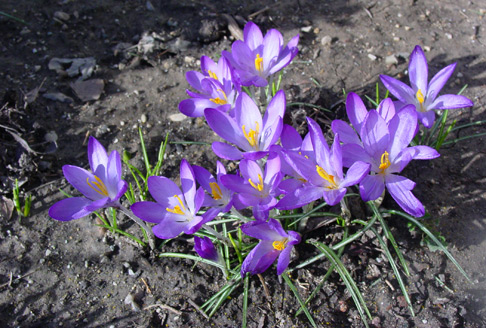As one of the most popular late-winter/early spring bulbs, crocus are widely available and easy to grow. They are one the first flowers of spring and come in a wide range of colors. The cup-shaped blossoms of the crocus are upward-facing and their flowers appear from late winter to early spring, depending on the variety and the local climate and most have grassy leaves with a white central stripe. Crocus flowers open fully only on sunny days.
I plant a lot of crocus bulbs (actually corms) and am continuously looking for new ways to keep them safe from squirrels who love to eat them. I planted some last fall in the front garden and placed paving stones on top to keep the squirrels away. I also kept some in the crisper section of our basement refrigerator all winter. My thought was that maybe the squirrels would be busy with other things in the spring and ignore them.
This spring when I removed the paving stones, my crocus plants came up and bloomed beautifully. However the crocus corms that wintered over in the refrigerator and were planted this spring have yet to come up. I am starting to think that the squirrels found and ate them all! I hate squirrels! Next year I am going to place screening on top of any new bulbs.
Propagation
Choose a sunny location for your crocus where the soil is not too wet over winter and during spring and plant your corms singly, or in groups at a depth of 2-4 inches. Do not plant a large number of crocus close together, as they can multiply rapidly. Fortunately, overcrowding does not seem to be a problem for crocus. Most importantly, select a spot for planting where you can view the crocus flowers from a window of your home. They produce a burst of spring color that you don’t want to miss. And of course as I mentioned, you will need to deal with the squirrels.





Your crocus photos are beautiful! Yesterday afternoon I noticed that mine were blooming all over the yard also.